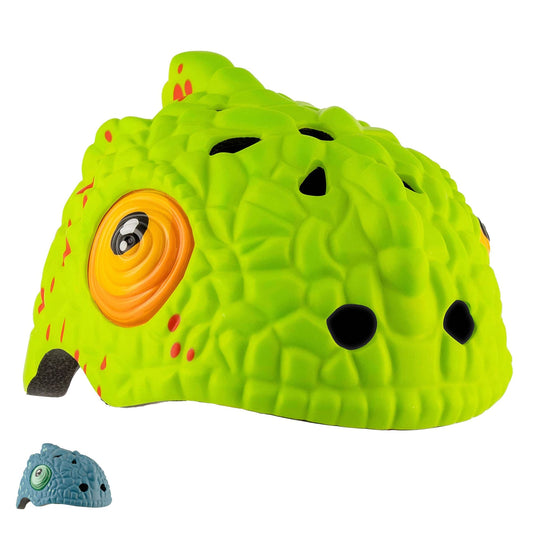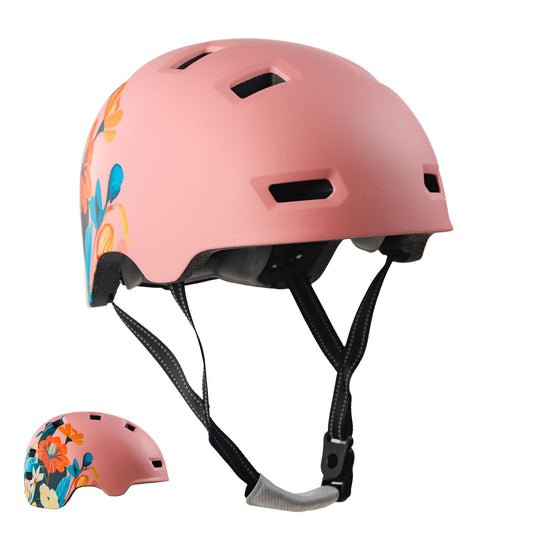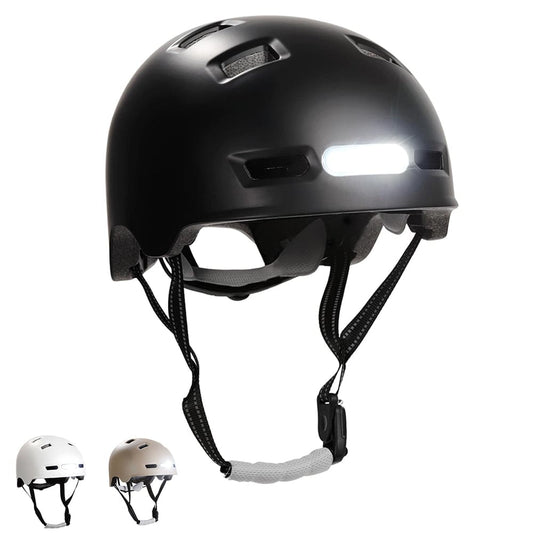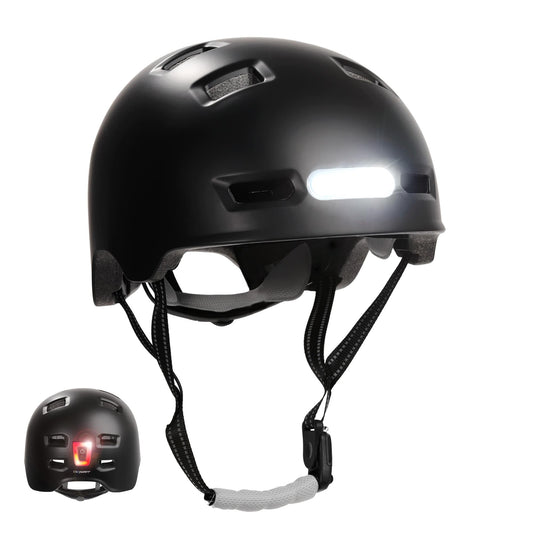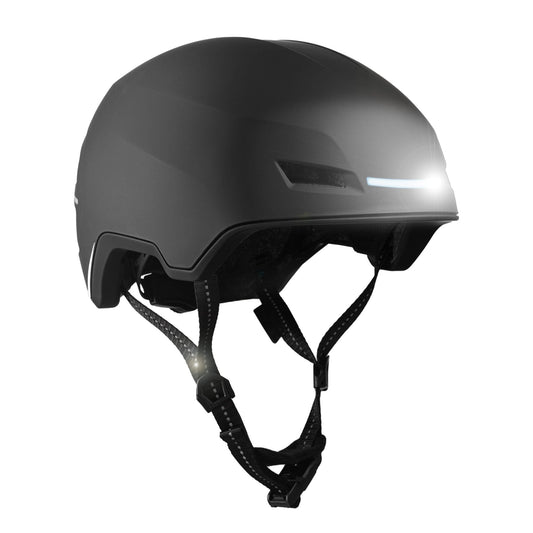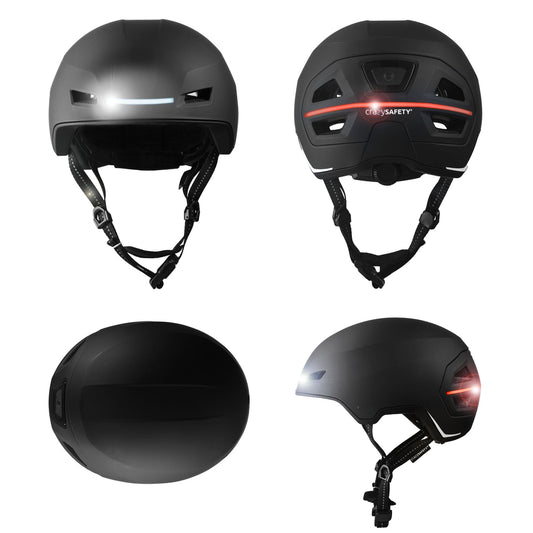Table of content
- Introduction
- Is it compulsory to wear a bike helmet?
- What Types of Bicycle Helmets Exist and which are the best bike helmets in 2023?
- How Do I Choose The Right Bike Helmet?
- How do I adjust a bicycle helmet for kids correctly?
- How to know the right bike helmet size for kids?
- Kids bike helmets - what safety features should I look for?
- Can bicycle helmets be worn for head protection in other sports?
- Should I replace a bike helmet after a crash?
Bike helmet wiki 2025
Looking for the best bike helmet for kids? We know that buying the perfect bicycle helmet for your child can be a challenge, so we've gathered the best advice and all the information you need to find the right bike helmet for kids. There's also lots of bonus information you can use when looking to buy a helmet for adults or youngsters/teens. Our advice is based on 20 years of experience in the bike helmet industry, including 10 years as CEO of ABUS Nordic (our CEO Kim Møller-Nielsen). You should see this article as a reference work, a kind of wiki for bicycle helmets 💪 Enjoy your reading!
Is it compulsory to wear a bike helmet?
Let's start with the easiest (surprisingly) - the legislation. When it comes to wearing a bike helmet, the laws and regulations can vary greatly depending on the country you're in. In some places, it's mandatory for all riders to wear a helmet, while in others it's not required at all.
Take Spain for example, helmets are not required for adult riders, but children under 16 years old must wear one. On the other hand, Denmark does not have any legislation mandating the use of helmets for cyclists. The Danish government instead focuses on promoting cycling as a safe and healthy mode of transportation through infrastructure improvements and education campaigns. France also does not have a national law requiring helmets, however, it is mandatory for children under 12 years old to wear a helmet while riding a bike. And in Germany, like Denmark and France, does not have a national law that requires helmets. However, some individual cities or regions may have their own regulations. Check the legislation by country in our blogs:
- Legislation about bike helmets in Spain
- Legislation about bike helmets in Denmark
- Legislation about bike helmets in Germany
- Legislation about bike helmets in France
But, here's the thing, just because it's not required by law, doesn't mean you shouldn't be rocking one on your ride! Think about it, a helmet can protect you from head injuries and even save your life in case of an accident.
In conclusion, whether or not it's compulsory to wear a bike helmet depends on the country you're in. While some countries mandate helmets for all riders, others do not require them at all. However, it is generally recommended to wear a helmet for safety reasons. Just remember, helmets aren't just for kids, they're for anyone who wants to protect their head and have fun while doing it! So, next time you're out for a ride, don't leave home without your trusty helmet sidekick.
What types of bicycle helmets exist and which are the best bike helmets in 2025?
Most bike helmets fall into six different categories: road, mountain biking, skate/BMX/full face helmets, commuter, kids helmets or e-bike helmets. The differences lie in the application, and there can also be significant price differences. We have gathered information in this article about types of bike helmets, where we also give our recommendations for good buys in our range and also in other brands' ranges. It is most important for us that you find the perfect helmet for your needs, because it is the optimal way to increase safety.
How do I choose the right bike helmet?
The most important thing is to choose the right helmet that suits you/your child and that you like - comfort and fit are key to making the helmet a faithful companion on every bike ride.
- Get the right size: You can definitely find a bike helmet for your head size. Make sure you measure the circumference of your head from the forehead (two fingers from the eyebrows) around to the neck to find the right size. We've created a more in-depth article on how to measure head circumference to find the right helmet here. It should be noted that if you have a fairly large head (from 62-65cm), there aren't many models out there, but we recommend the ABUS Urban I 3.0.
- Determine what type of helmet you need: It's important to consider the type of cycling activity you or your child will be participating in, and decide for a helmet that is appropriate for that activity.
- Look for quality assurance stickers and certifications: In order to ensure that your chosen helmet meets certain safety standards, it's important to look for certifications such as those provided by the European Union (EN 1078; 2012 + A1: 2012) or the CPSC (Consumer Product Safety Commission). It is very important as these certifications guarantee that the helmet has been tested and meets the safety requirements!
- Consider durability: You want a helmet that will last for several years without losing its protective qualities. This is especially important when purchasing a children's bicycle helmet, as they may be more prone to rough handling. It's worth investing in a higher quality, more durable helmet, as it will provide better protection and may save you money in the long run.
- Think about comfort: It's important that you or your child feels comfortable wearing the helmet, so look for extra padding on the inside-and even better if that padding is washable! Ventilation is also important!
- Research different models and designs! Before purchasing a bicycle helmet for your child or for yourself!, it's important to do some research to find a model that provides enough protection and has a design that your child will love. Look for reviews and compare the features of different helmets to find the best option for your child. They will be more likely to wear their helmet consistently if they are excited about the design, for example the Crazy Safety Animal helmets are the helmet that children never forget to wear because there are so many animals in different colours. Parents simply don't have to remind the child to use the helmet - it comes naturally!
How do I adjust a bicycle helmet for kids correctly?
Fitting a children's helmet correctly is an important step in ensuring their safety while cycling!
Too many people adjust their helmet incorrectly, which means that they don't get the optimum protection, so it doesn't really matter. Like putting a pair of safety glasses on your forehead.
We've put together an article with a step by step video and all the tips for adjusting your bike helmet to fit correctly - whether for yourself or your child - the focus is on protecting your head as best as possible!
You can still find here the basic steps on how to fit a kids' helmet correctly:
- Position the helmet on the head: The helmet should sit level on the child's head, with no more than two fingers width between their eyebrows and the top edge of the helmet.
- Secure the straps correctly: The straps should be tightened so that the helmet fits snugly on the head, but not so tight that it becomes uncomfortable.
- Adjust internal pads or back dials if necessary: Additionally, many bike helmets for kids come with easy-to-adjust chin straps and back dials for a more comfortable fit; this is especially helpful for growing kids!
It's important to take the time to properly fit a kid's helmet in order to ensure that it provides the necessary protection in case of an accident or crash.
How to know the right bike helmet size for kids?
The most important part of finding the right size for a bike helmet for kids is measuring your child's head before choosing from the many different helmets on the market. In fact, this applies to all ages. You can see our dedicated post with a video explaining how to measure the head to know what is the right helmet size for kids.
- To get the perfect cycling helmet for children, you'll need to measure their head. Use a tape measure to measure the circumference of the head, then check the manufacturer's sizing information. It doesn't matter which brand it is. ABUS, Nutcase, MET, Giro, Bell or one of our Crazy Safety helmets - they're all measured the same way!
- Make sure to check reviews from customers using same product - these can provide invaluable insight regarding how well particular helmet model actually sits on certain sized heads!
- Have professionals help determine appropriate size if needed - you can always drop us a comment or send us an email and we will be happy to help!
Kids bike helmets - what safety features should I look for?
When it comes to selecting a bicycle helmet for your child, safety should be your top priority. There are several features to look for when choosing cycling helmets to ensure your kid is protected while riding:
- One important feature to look for in a bicycle helmet is an in-mold construction. IIn-mold helmet construction means that the outer shell is molded together with the EPS material, creating a more durable and lightweight bicycle helmet.
- Secure fit. A secure fit is essential to keep the helmet in place and protect the head, so make sure to measure your children's head and choose a helmet size that fits properly.
- Good ventilation system to help keep your child cool and comfortable while riding. Look for helmets models with multiple vents or an airflow design to allow for proper ventilation.
- Extra Features like lights or reflectors. We recommend that all children ride with helmets that have lights in the back of the head for extra safety. It is important to stress that it can never replace a normal approved rear light, because such a light must be fixed to the bike. But either way, you increase visibility in the dark. And if you're on a scooter or rollerblades, it doesn't hurt to be more visible in traffic! Some bike helmets have reflectors, either on the shell or in the straps.
- Choose a helmet that meets safety standards, such as the CPSC or EN 1018 which is the European CE standard. A label inside the helmet should indicate when and where it was produced and whether it is approved to EN1078. All our bicycle helmets in Crazy Safety are of course approved.
Can bicycle helmets be worn for head protection in other sports?
Yes! Bicycle helmets can also be worn when in-line skating, roller skating or sledding. Skateboarders or skaters who perform tricks might want to look for helmets specifically designed for these activities and that meet safety standards for these sports. These helmets cover more of the head, especially the back of the head.
We do not recommend to use bike helmets for any other purpose than the stated on the manufacturer label.
What can I do to encourage my kid to use bike helmets?
To encourage your child or toddler to wear a helmet, start the helmet-wearing habit at a young age. Let your child know that whether you are cycling, riding a scooter or tricycle, riding a cargo bike, etc., a helmet must be worn.
As long as the helmet fits properly, let your child choose their own new bike helmet. Children will be more likely to wear a helmet if they have chosen it themselves and it has an attractive design. After all, they need to remember to wear the helmet, so it's a good idea for even young children to help in choosing it.
Adults should set an example and also wear a helmet when biking! Fortunately, we see that many parents are now using bicycle helmets so that their children can do the same. You might as well cycle safely - the whole family! We have also made an article with 7 hack here.
Should I replace a bike helmet after a crash?
Yes, it is important to replace a bike helmet after a crash or accident. After a crash, the helmet's structure and materials may be compromised, which could reduce its ability to protect the head in the event of another impact.
With these tips you can confidently filter among all the kids helmets available in our shop and in the market, getting the one that both keeps them safe while also being comfortable and cool, and durable enough to withstand rigorous use over time!
Thanks for reading!, If you feel we are missing something, or would like our help choosing a bike helmet let us know in the comments!
On behalf of the team
Zdenko and Kim, Crazy Safety


